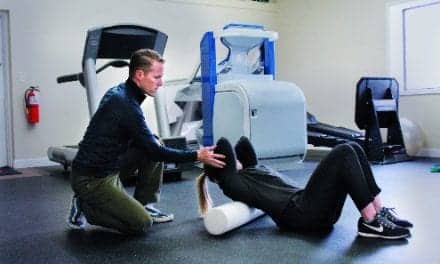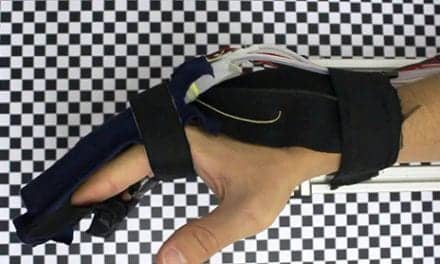With so many choices and so many claims floating around, we asked therapists and facility owners Aaron Willis, DPT, ATC, owner of Playa Physical Therapy, Los Angeles; Robert W. Babb, PT, MBA, founder of the Physical Therapy & Wellness Institute (which has three Pennsylvania locations in Quakertown, Lansdale, and Montgomeryville); Cynthia Wood, RPT, owner of Beyond Physical Therapy, Marina del Rey, Calif; and Andrea Avruskin, PT, DPT, ATC, LAT, staff physical therapist at Select Physical Therapy, Las Vegas, what it takes for them to part with their money and bring new items into the clinic.
Rehab Management What criteria do you take into consideration when choosing equipment for your facility?
Andrea Avruskin, PT, DPT, ATC, LAT One of the most important factors is multiple usage of a single piece of equipment. That is, can you use it for more than one thing? And for more than one type of injury? The other important aspect is durability.
If I could have just one piece of equipment, it would be a standing/upright cable column. It has adjustable resistance and adjustable setups. I can use it for any part of the body and a wide range of injuries. The highest-quality and best-designed brand is FreeMotion Cable Cross, which I first used at the gym. In my opinion, this is the best investment because it offers so much diversity, is so adjustable, and is broadly applicable across the spectrum of orthopedic and neurologic patients—young and old, athletic or inactive. It is durable, requires minimal maintenance—and no IT department. I can use it for any part of the body or any patient—whether weightbearing or non-weightbearing; for upper body, lower body, or core; for elite athletes to patients recovering from strokes.
My other recent favorite equipment is the BOSU ball. It took me a little while to be won over by it, but it is useful for everyone from skiers, to gymnasts, to geriatric patients. It is low-tech, but it challenges different body systems appropriately to improve balance and stability. And it never needs to be reprogrammed, rebooted, or updated. I was introduced to it first at the gym by watching personal trainers making their clients use them. Then during a PT conference, an instructor used it to teach us some new core exercises during one of the conference classes. Once I used it, I could see a dozen ways to apply it in the clinic. My patients have never forgiven me.
Robert W. Babb, PT, MBA It begins with your demographic usage. Who is going to use the equipment? How easy is the equipment to use? It is important to have some fairly simple, sturdy, highly visible, and visually appealing equipment in your facility. I lean toward Cybex and Magnum, because Cybex is a name that people recognize and Magnum is some of the sturdiest equipment you can find. I try to spray the rest of the clinic with highly functional yet inexpensive pieces that are unique to physical therapy, such as the shoulder closed chain strengthening wheel that is used on the ground. I have various fitness balls and slide boards for proprioceptive training—and I try to line the clinics throughout with specialty equipment. These are not too expensive, and you can fill up your clinic with them.
As far as deciding what purchases I am going to make—well, I nearly purchased a new building, but just decided against it. The cost of equipment, the cost of a new pool, and the cost of bringing the interior of this building up to our standards all factored into the decision. We did not want just white walls. We wanted atmosphere, and part of that atmosphere is equipment. We wanted an atmosphere that was lively and filled with human and physical resources. Part of the reason I pulled the plug on this deal was the equipment factor. I could go out and put in substandard equipment and build an interior that is not consistent with the atmosphere that I am trying to create, and I probably could have done it for half the price. However, that is not the brand we are trying to build. It is not consistent with the foundation of our practice.
Aaron Willis, DPT, ATC When choosing exercise equipment, I must take into account what physical space I have available in the gym, what I can afford at the time, and what type of patients will be using the equipment. At this point, I am usually trying to fill some gap I have come across in working with patients—where I feel a new piece of equipment will be helpful and widely used.
Demographics is the most important factor right now. I focus my purchases on helping the types of patients I am seeing. There are a lot of great pieces of equipment out there. However, if I am not seeing the appropriate patients to use that equipment, it is not worthwhile.
Cynthia Wood, RPT We are Pilates-based, but we also have sports medicine equipment, including trampolines, treadmills, bikes, and ellipticals. We do a lot of improvising with equipment. One of the reasons we have Pilates equipment is that it is so versatile. You can pretty much simulate any sport on a Pilates reformer.
For us, deciding what to buy is based on effectiveness and efficiency. How versatile is the equipment? Effectiveness and versatility are the most important factors. I don’t care if it is a $5 piece of plastic—if it is the hottest thing and the most effective thing for everybody, then great. A $10,000 piece of equipment that you can use on only two out of 25 patients is not going to be worth it.
Rehab Management What are your purchasing protocols for high-tech and low-tech fitness equipment?
Avruskin We have a relationship with a medical supply company, and we have a history with them. They have given us consistently good deals, but we also go out and price things just to compare. But they always come back with really good deals, plus they come in and set it up for us if we need that.
Babb We do all the bargaining ourselves, and we probably do it the hard way, but I also think we do it the most cost-efficient way. We negotiate and we make calls to every specific equipment manufacturer. We do buy some used equipment, and it is usually Magnum or Cybex. I have a person who buys equipment, and I have known him for more than 20 years; I call him up every once in a while and say ‘If you happen to have a certain machine coming your way, tell me about it.’ He often comes up with the equipment because he is buying it from hotels and health clubs that are moving on to new lines.
I also go to him and ask if he can get me quotes on new equipment, and we will call around also. I have an assistant who makes all the calls. There are smaller items that we like to have around such as physioballs and bands. We have an [exercise band] station at each one of our clinics. We have several cable units that are on wheels.
Wood We do research ourselves on the Internet or through vendors or colleagues. We do that due diligence ourselves, and once we narrow it down, we will go to that vendor. I believe in business loyalty. We have long relationships with certain vendors, and if I think they can get me a piece of equipment, I will go to them first and ask them ‘What is the best you can do for me?’ If they can’t be competitive, I will see if they can match a price so that we can maintain a business relationship. If they can’t, it is a respectful process to decide on going elsewhere. And I am very up front about that so it does not burn any bridges, and it keeps everyone in the loop. Certain vendors know that I will give them first dibs on some things. With bigger equipment, we generally go through the manufacturer. We also primarily deal with Dynatronics.
Willis I would not say I have a set protocol, but we will check two to three places for any product we are purchasing. For products I will need to buy often through the year, I make a note of where we have gotten the best deal to avoid repeating the process each time. I definitely recommend getting to know the reps from the various companies you order from, because they will often give you deals to earn and/or keep your business.
Rehab Management How do you learn about new equipment?
Avruskin When we go to our conferences, there is always a vendor room and vendors bring their new equipment and let us try everything out. Sometimes they even sponsor a lecture and explain the benefits of the equipment. The other way that a lot of us get exposed to new equipment is at the gym. Most of us belong to gyms and they are pretty well stocked, and they get new equipment in and we’ll try it out.
Babb I am a trade show guy. We go to the private practice national meeting every year [American Physical Therapy Association] and try to get out to the Combined Section Meeting every year. And typically we will purchase items at these meetings. We try them, play with them, and listen to the representatives who are there. It is easier for me to go to them and see a whole bunch of equipment, rather than having one come to my clinic and I have to listen to their sales pitch for an hour. It is a lot more efficient for me to go to them.
Wood I don’t go to many trade shows. I basically find out through the community, news, and the media. I look at journals and magazines and speak with other people/colleagues in the fitness industry. Being in Los Angeles, you are certainly on the cutting edge of the fitness world.
Rehab Management Are you an early adapter of new devices, or do you prefer a wait-and-see philosophy?
Avruskin If it is an expensive piece of equipment that is not easily available, and will take a long time for me and other people to use effectively, then it might take a while for me to acquire it. If it is low-tech, affordable, and easy to acquire, I will probably use it the next day.
Babb We are a wait and see. We are still holding out on some of the new iontophoresis pads. We won’t jump the gun on some of the trendier stuff. We like to hang tight and see how these things pan out. There are a lot of trends in our field, and the folks at Rehab Management certainly know that. Trends come and go. In the end, it comes down to your people and your empathy. It is your ability to strike a relationship and have a meaningful conversation with your clients in front of you.
Willis As far as purchasing for the clinic, I would not call myself an early adapter of new devices. I try to keep up with what is out there, but I like to see how it is being used, what the research says—if available—and be able to try it out before buying.
Wood We are definitely one of the leaders as far as having new things. As an example, we were one of the first people in Los Angeles to incorporate Pilates. We were not the only ones, but there were only a handful of us about 10 years ago, and now it is a part of almost everyone’s practice.
As another example, we sell [a brand of] shoes with a rounded bottom that cause you to co-contract all day long—and challenge your balance all day long. We are the first clinical distributor for these shoes. They are being marketed as the smallest gym in the world. Patients love them, and you are getting a pretty good workout just wearing the shoes. That is an example of us taking what is out there and putting a clinical therapeutic spin on it. We have people [with] chronic hip pain—and they are benefiting from physical therapy—but when they wear the shoes, they are balancing better and using their bodies more efficiently. Our [practice] is called Beyond Physical Therapy, and we really do embrace that philosophy of finding the latest and greatest thing—not items that are all hype, but those that actually get results. We are always looking for that next thing.
Rehab Management What criteria and/or variables do you consider when setting up home fitness regimens?
Avruskin I ask my patients what their home environment is like. What kind of furniture do they have? Is it sturdy? If I know that, I can determine whether they can attach an [exercise band] to the furniture. I ask if they have a gym membership. And I also have to consider whether they can drive themselves to the gym. If they can’t, I have to keep it simple with things such as cuff weights and body weight exercises.
Babb There are studies that show that a lot of folks who build a gym in their basement stop using it after a few months. I always ask people to take that into consideration, and if you can, a lease-to-own situation might be better. I also tell patients to work the large muscle groups, instead of spending time on biceps, triceps, and shoulders. Work those large muscle groups because those are the key to longevity.
Wood With home fitness and rehab, the primary consideration is the patient’s resources. Does the patient already have a gym membership? Does the patient have nothing? Are there resources at home or do we need to create a program that fits their needs and their means? For someone who does not have weights or a gym membership, it is not realistic that they are going to become a bodybuilder type. We take into consideration what they want to achieve based on their resources.
Willis Early in the course of treatment, I try to get a good understanding of what type of space patients have at home, how much time they realistically have for their program, and how well they follow instructions. This information helps determine what I will prescribe for patients to do at home. Equipment for home use, such as bands and foam rolls, will only be issued once the patient demonstrates correct use in the clinic.
—Compiled by Greg Thompson




